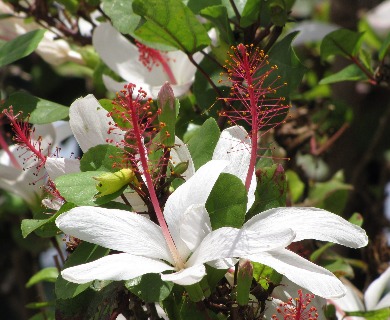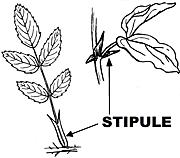Koki’o Ke’oke’o
Hibiscus arnottianus
Mallow family (Malvaceae)
Native species ()
Small tree or tall shrub native to Oahu and sometimes cultivated, with showy large fragrant funnel-shaped flowers about 5–6 inches (13–15 ) across the five spreading elliptical white petals. 10–30 ft (3–9 ) high, with several trunks 3 inches (7.5 ) or more in diameter, with dense hairless throughout (a variety hairy). Bark gray, smooth; Inner bark is light green, almost tasteless. Twigs green when young, becoming gray with raised half round leaf scars.

©2009 Forest And Kim Starr
Flowers single on jointed stalks at one or two uppermost leaves. tubular, cylindrical, light green, 2 long, five- and split on a side, above 5–7 narrow, curved green petals five, white, sometimes pinkish, 3–4 1⁄2 inches (7.5–11 ) long, united at base into narrow tube 1 inch (2.5 ) long; many threadlike along the upper part of a long dark red or white column extending from tube 3 1⁄4–4 inches (8–10 ), enclosing cylindrical, five-celled with several ovules in each cell, the slender with five exposed erect dark red branches ending in brown dot stigmas.
Seed capsules are oblong, 1 inch (2.5 ) long, thin-walled, five-celled, enclosed by Seeds 3⁄16 inch (5 ) long, brown hairy.
Native only on Oahu and Wailau Valley, Molokai, in wet forests at 1000–3000 ft (305–914 ) elevation. Originally common in mountains near Honolulu.
Special areas
Lyon Arboretum, Waimea Arboretum, Maui Zoological and Botanical Gardens, Wahiawa Botanic Garden, Kapiolani Rose Garden near Honolulu Zoo, and Manuka State Park on Hawaii
Other common names
Pā-makini, Punaluu hibiscus (variety with large heart-shaped hairy leaves). A common name for Hibiscus is pua aloalo, which refers to the flower. Aloalo refers to the whole plant.
This species named in 1854 honors its discoverer, George Arnold Walker Arnott, (1799–1868), Scottish botanist. It is mentioned in old Hawaiian songs and legends.
Several other mostly shrubby species of Hibiscus, with flowers of assorted colors, are native in Hawaii. H. arnottianus is a source of numerous horticultural varieties, which are popular ornamentals. Its flowers last longer, 2 days instead of 1.
White Kauai hibiscus, Hibiscus waimeae Heller, also with showy white flowers, is native to Kauai and common in Waimea Canyon at 2000–3000 ft (610–914 ). This small tree reaches 30 ft (9 ) and 1 ft (0.3 ) in trunk diameter. It is easily cultivated and can be seen at most special areas listed above.





